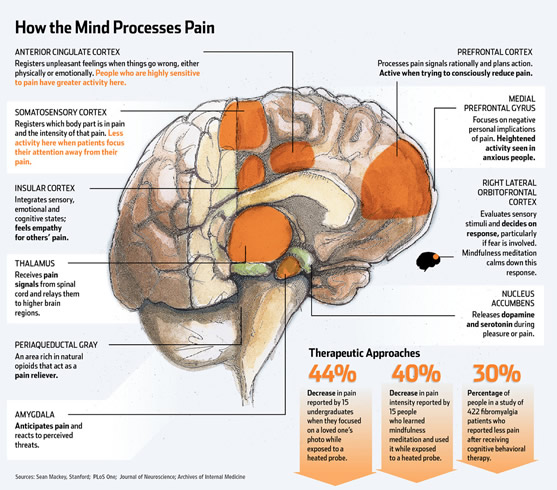Published: November 16, 2011

Source: Sean Mackey, Stanford. Plos One, Journal Neuroscience: Archives of Internal Medicine
Melinda Beck’s Wall Street Journal article Rewiring the Brain to Ease Pain looks at how you think about pain can have a major impact on how it feels.
That’s the intriguing conclusion neuroscientists are reaching as scanning technologies let them see how the brain processes pain.
That’s also the principle behind many mind-body approaches to chronic pain that are proving surprisingly effective in clinical trials.
Some are as old as meditation, hypnosis and tai chi, while others are far more high tech. In studies at Stanford University’s Neuroscience and Pain Lab, subjects can watch their own brains react to pain in real-time and learn to control their response—much like building up a muscle. When subjects focused on something distracting instead of the pain, they had more activity in the higher-thinking parts of their brains. When they “re-evaluated” their pain emotionally—”Yes, my back hurts, but I won’t let that stop me”—they had more activity in the deep brain structures that process emotion. Either way, they were able to ease their own pain significantly, according to a study in the journal Anesthesiology last month.
Link to read article
Source: Wall Street Journal
 Meditation produces powerful pain-relieving effects in the brain, according to new research published in the April 6 edition of the Journal of Neuroscience.
Meditation produces powerful pain-relieving effects in the brain, according to new research published in the April 6 edition of the Journal of Neuroscience.
“This is the first study to show that only a little over an hour of meditation training can dramatically reduce both the experience of pain and pain-related brain activation,” said Fadel Zeidan, Ph.D., lead author of the study and post-doctoral research fellow at Wake Forest Baptist Medical Center.
“We found a big effect – about a 40 percent reduction in pain intensity and a 57 percent reduction in pain unpleasantness. Meditation produced a greater reduction in pain than even morphine or other pain-relieving drugs, which typically reduce pain ratings by about 25 percent.”
For the study, 15 healthy volunteers who had never meditated attended four, 20-minute classes to learn a meditation technique known as focused attention. Focused attention is a form of mindfulness meditation where people are taught to attend to the breath and let go of distracting thoughts and emotions.
Both before and after meditation training, study participants’ brain activity was examined using a special type of imaging — arterial spin labeling magnetic resonance imaging (ASL MRI) — that captures longer duration brain processes, such as meditation, better than a standard MRI scan of brain function. During these scans, a pain-inducing heat device was placed on the participants’ right legs. This device heated a small area of their skin to 120° Fahrenheit, a temperature that most people find painful, over a 5-minute period.
The scans taken after meditation training showed that every participant’s pain ratings were reduced, with decreases ranging from 11 to 93 percent, Zeidan said. [continue reading…]
Published: February 22, 2011
Ferris Jabr discusses research that finds how looking at a picture of a loved one can dull physical pain.
Many mothers offer their young children a hand to squeeze as they brave a vaccination in the doctor’s office. We instinctively know that contact with a loved one can help mitigate pain—and the scientific evidence concurs. Now two recent studies show that a mere reminder of an absent beloved—a photograph—can deliver the same relief. Curious? Continue reading
Source: Scientific American
 When it comes to pain, the two competing schools of thought are that it’s either “all in your head” or “all in your body”. A new study led by University of Oxford researchers indicates that, instead, pain is an amalgam of the two.
When it comes to pain, the two competing schools of thought are that it’s either “all in your head” or “all in your body”. A new study led by University of Oxford researchers indicates that, instead, pain is an amalgam of the two.
Depression and pain often co-occur, but the underlying mechanistic reasons for this have largely been unknown. To examine the interaction between depression and pain, Dr. Chantal Berna and colleagues used brain imaging to see how healthy volunteers responded to pain while feeling low. [continue reading…]



